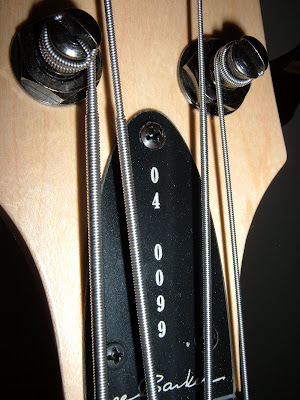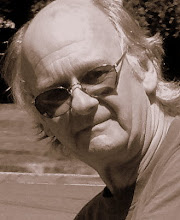 The new purple abalone knobs came from Qparts (q-parts.com) with the express intention of doing a quick and subtle upgrade to #99, Ginner, described in an earlier post.
The new purple abalone knobs came from Qparts (q-parts.com) with the express intention of doing a quick and subtle upgrade to #99, Ginner, described in an earlier post.The knobs are labeled "black" but I knew that it was not the coal black, but the silver black they were describing, and that matches exactly the tuning machines on Ginner.
But alas the knobs were too big, too much girth.
Tim, my business neighbor, guitar player and laser genius, took a look at my quandary and said, "Brass, sure, I can do that!" and in about 20 minutes he had all three turned down on his little mill (see illustration). That shoulder allows the knobs to fit into the counterbore that is one of the hallmarks of our design.
I took a picture precisely 1/3 through the installation so you can see the difference between the two knob designs.
It is reasonable to explore the possibility that the new ones do not protrude enough for rapid deployment. I'll know in a week or two. Because of the Stellartone retrofit, the pot shafts middle and lower are shorter, so the knobs sit down in the counterbores a bit more than the stock knobs, which are taller to boot. As a result, the top pot has to be lowered in the cavity a little bit--requiring an extra nut and washer. If your B1 is stock, it will need three extra nuts and washers (which I can furnish for you).
Meantime I am feeling like a 50's kid (and I am one) that just got a new set of hubcaps for his '51 Shoebox Ford DeLuxe Coupe with torched springs in front and Fingerhut seat covers. (I don't have one.)
One note if you choose to go this way: the knobs are packaged individually. Of my three, one was in perfect condition but the other two were abraded on the abalone surface. They had a dull, not shiny look. I noticed this too late, and rather than return them I had to fix them. About a half hour with Micro-Mesh abrasives and a little water, and all three shine like the sun off a just-thawed pond on a late winter morning.
In retrospect, it's just a little gift I gave myself. Excuse me, I've got to go write a thank you note now...












